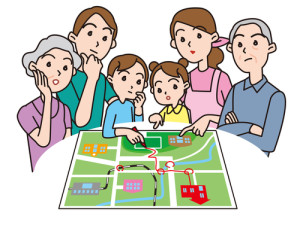 When you move into your new home, you may not think to revise and update your emergency plan, but natural disasters strike without warning. Avoid being caught without a plan in place at your new address. Here are ten steps to take to make sure you are ready the day you move in and continue staying prepared to keep your family safe.
When you move into your new home, you may not think to revise and update your emergency plan, but natural disasters strike without warning. Avoid being caught without a plan in place at your new address. Here are ten steps to take to make sure you are ready the day you move in and continue staying prepared to keep your family safe.
Sounds simple, right? Despite all of the natural disasters, fires, storms and mishaps in the news, many people do not have a plan for where to go, what to do, and how to reconnect with family members.
1. Learn what disasters affect your area and stay in the loop to receive early warning. Local city or community websites often provide information about natural disasters affecting your area. Use your community’s resources to prepare.- WEAs: The national weather service provides free Wireless Emergency Updates (WEAs)—text message warnings and updates customized to your area. Check with your wireless carrier to make sure your device is WEA-capable and the service is enabled. Capable devices automatically receive government updates.
- Check out apps like Weather Bug and Simple Weather Alert that offer weather warnings straight to your phone or desktop.
- Listen to NOAA Weather Radio for information.
2. Know where to find shelter locations and learn how to “shelter in place”: Make sure you know where in your home is the safest and what community resources you can rely on to help you if you are not able to get home. If you have children, investigate the emergency response plan at their school to double-check their safety outside the home.
- Hurricanes: Turn off propane tanks and small appliances. Switch your fridge and freezer to the highest setting and secure them closed if possible (if the power goes out you’ll want the cold to last as long as possible). Close all windows, doors and hurricane shutters. If possible, board up any windows without hurricane shutters (hurricane specific items to keep in the kit discussed below).
- Tornadoes and Thunderstorms: Know where your safest underground shelter is at work and at home, i.e.: basement, storm cellar, etc. If you do not have an underground shelter, find your most protected interior room such as a closet, hallway, or bathroom.
- Floods: When you receive a flood warning, whether at home or outside, move immediately to higher ground. If you are outdoors, be aware of drainage channels, canyons, or streams nearby. They fill with water quickly and may cut off your evacuation route.
- Earthquakes: Secure furnishings, decor, and appliances to avoid damage or injury during ground movement.
- Safe Spots: Know the safe spots in your home—inside walls and under furniture—and areas in your home to avoid near hanging objects, windows, and mirrors.
- Self Protection: When an earthquake starts, drop to your hands and knees and move to the nearest safe spot immediately while covering your head and neck. Secure yourself and continue bracing your head and neck.
- Fire: When a fire occurs in your home, get out and stay out. Move to safety before calling 911. Create a map of your home and memorize all possible exits to escape the fire. Practice low-crawling and Stop, Drop & Roll. Select a meeting place for your family so everyone knows where to go once they get out safely.
- Evacuation Preparedness: City or community-wide evacuations can be chaotic and scary; keep yourself calm and safe by preparing ahead. Make sure your safety kit (below) is accessible in the event you need to evacuate quickly. Keep extra fuel available for your vehicle—you may not have enough warning to get to a gas station before needing to evacuate. Visit your local community website to learn the evacuation procedures and locations for your area so you know what to do. Obey evacuation orders immediately. Stalling to “see if you really need to” puts yourself and others in danger and taxes emergency personnel unduly.